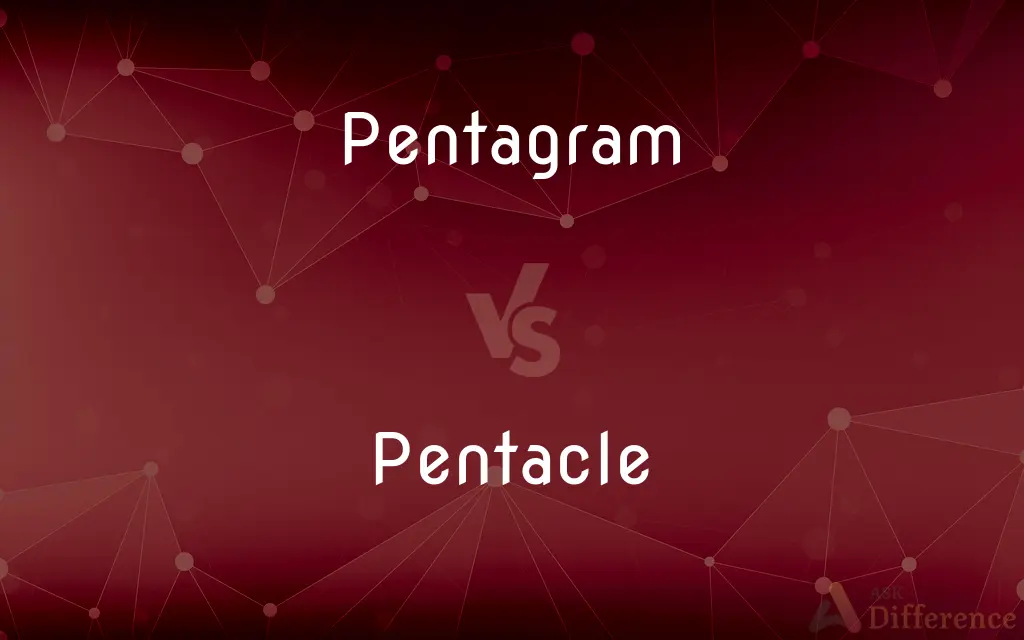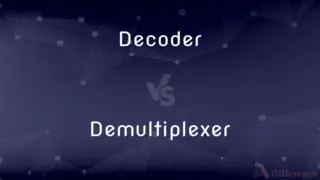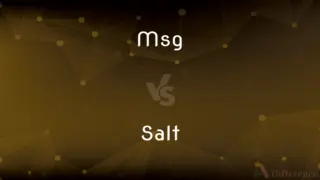Pentagram vs. Pentacle — What's the Difference?
By Tayyaba Rehman — Updated on October 30, 2023
A Pentagram is a five-pointed star; a Pentacle is a pentagram within a circle or used in magical contexts.

Difference Between Pentagram and Pentacle
Table of Contents
ADVERTISEMENT
Key Differences
Pentagram and Pentacle are often confused terms with distinct meanings. A Pentagram is a geometric figure featuring a five-pointed star, commonly associated with various cultural and spiritual contexts. Its points often represent elements like earth, air, fire, water, and spirit. In contrast, a Pentacle refers to a Pentagram encased within a circle. This circled star is widely recognized in occult and magical practices, symbolizing unity, protection, and the connection between the material world and the cosmos.
While a Pentagram stands alone as a star with interwoven lines, the Pentacle enhances this symbolism through its encompassing circle. The Pentagram, independent of the circle, has historical ties ranging from ancient Mesopotamia to modern neopaganism, often representing balance and interconnectivity of forces. However, when enclosed in a circle, the Pentagram transforms into a Pentacle, often used in magical traditions, signifying containment of power and connection to the infinite.
The Pentagram's presence in various religions and philosophies highlights its versatile nature. It appears in Christianity as a symbol of the five wounds of Christ, and in Pythagorean tradition as a sign of health and knowledge. Conversely, the Pentacle, specifically in its circled form, is more closely aligned with magical practices, particularly in Wicca and other neopagan religions, where it serves as a talisman or a tool for ritualistic purposes.
Both Pentagram and Pentacle have experienced shifts in perception over time. The Pentagram, once a symbol of balance and protection, has been misconstrued in some instances as a sign of the occult or even evil, especially when inverted. The Pentacle, however, retains its magical and protective connotations, remaining a primary symbol in contemporary magical practices, encapsulating the essence of the Pentagram within its encompassing circle.
Comparison Chart
Basic Shape
Five-pointed star
Five-pointed star within a circle
ADVERTISEMENT
Symbolic Representation
Elements, balance, protection
Magical protection, unity, infinite cycle
Cultural Usage
Broad usage in various cultures
Primarily used in magical and occult contexts
Perception Shift
From sacred to occasionally misconstrued
Remains predominantly magical and positive
Connection to Magic
Less direct, more symbolic
Strongly associated with magical rituals
Presence in Religious Art
Seen in multiple religious contexts
Mostly absent outside of magical traditions
Compare with Definitions
Pentagram
A geometric star symbol with five points.
The ancient temple had a pentagram carved into its entrance.
Pentacle
A pentagram enclosed within a circle, used in magical contexts.
The altar was adorned with a pentacle to invoke protection.
Pentagram
A symbol used in various religious and cultural contexts.
The pentagram has appeared in Christian, Pagan, and Wiccan traditions.
Pentacle
A talisman or amulet in neopagan and Wiccan practices.
She wore a pentacle for spiritual guidance and defense.
Pentagram
A star with interlocking lines, often encased within a circle in some traditions.
The necklace had a simple pentagram, not encased in a circle.
Pentacle
An emblem used in ritual magic and ceremonial practices.
The magician placed his tools within the pentacle during the ceremony.
Pentagram
A representation of the elements earth, air, fire, water, and spirit.
Each point of the pentagram corresponds to a different elemental force.
Pentacle
A symbol representing the unity of the five elements and the cosmic cycle.
The pentacle embodies the eternal cycle of life and nature.
Pentagram
A figure used in magical practices and occultism.
The witch drew a pentagram on the ground during the ritual.
Pentacle
A protective symbol in various occult traditions.
The pentacle was inscribed on the book cover for protection.
Pentagram
A pentagram (sometimes known as a pentalpha, pentangle, pentacle or star pentagon) is the shape of a five-pointed star polygon. Pentagrams were used symbolically in ancient Greece and Babylonia, and are used today as a symbol of faith by many Wiccans, akin to the use of the cross by Christians.
Pentacle
A pentacle (also spelled and pronounced as pantacle in Thelema, following Aleister Crowley, though that spelling ultimately derived from Éliphas Lévi) is a talisman that is used in magical evocation, and is usually made of parchment, paper, cloth, or metal (although it can be of other materials), upon which a magical design is drawn. Protective symbols may also be included (sometimes on the reverse), a common one being the six-point form of the Seal of Solomon.
Pentagram
See pentacle.
Pentacle
A five-pointed star, often held to have magical or mystical significance, formed by five straight lines connecting the vertices of a pentagon and enclosing another pentagon in the completed figure. Also called pentagram.
Pentagram
The shape of a five-pointed star constructed of five intersecting lines meeting at the vertices, such that a central pentagon and five surrounding isosceles triangles are formed; often with magical connotations; a 5/2 (or 5/3) star polygon.
Pentacle
A flat talisman, almost always star-shaped, made of parchment, sheet metal, or other substance, marked with a magic symbol or symbols, used in magical evocation.
Pentagram
A pentacle or a pentalpha.
Pentacle
(Wicca) A pentagram, or a disk with a pentagram on it, especially one that is used for magical or mystical purposes.
Pentagram
A star with 5 points; formed by 5 straight lines between the vertices of a pentagon and enclosing another pentagon
Pentacle
(Wicca) A circumscribed pentagram.
Pentacle
A figure formed by two equilateral triangles intersecting regularly so as to form a six-pointed star.
Pentacle
A five-pointed star, also called a pentagram or pentalpha. See illustr. under pentalpha. Sometimes referring to a similar figure, such as the figure composed of two equilateral triangles intersecting so as to form a six-pointed star. It was used in early ornamental art, and also with superstitious import by the astrologers and mystics of the Middle Ages. The six-pointed star is more comonly called a hexagram, or called Solomon's seal; it resembles the star of David (Magen David
Pentacle
A star with 5 points; formed by 5 straight lines between the vertices of a pentagon and enclosing another pentagon
Common Curiosities
What is a Pentagram?
A Pentagram is a five-pointed star, often representing elements and balance.
Is the Pentacle used in magic?
Yes, it's commonly used in magical and occult practices for protection and rituals.
Does the Pentacle have negative connotations?
Generally, it's seen as positive, symbolizing protection and unity in magical traditions.
Can a Pentagram be inverted?
Yes, but its meaning can change, sometimes representing darker aspects in popular culture.
What is a Pentacle?
A Pentacle is a Pentagram enclosed in a circle, used in magical contexts.
Is the Pentagram a religious symbol?
Yes, it appears in various religious and cultural contexts with differing meanings.
Is the Pentacle exclusively a Wiccan symbol?
No, but it's prominently used in Wicca and other neopagan religions.
Are Pentagrams and Pentacles the same?
No, a Pentagram is a star alone, while a Pentacle includes a circle around the star.
Can Pentagrams be part of artistic designs?
Absolutely, Pentagrams are often incorporated into art, architecture, and design.
What do the points of a Pentagram represent?
They often symbolize earth, air, fire, water, and spirit.
Are Pentagrams and Pentacles used in modern times?
Yes, they are still widely used in various spiritual, religious, and cultural contexts.
Can a Pentagram be a personal symbol?
Yes, individuals may use it for personal significance or spiritual representation.
Is it common to wear a Pentacle as jewelry?
Yes, many wear Pentacle amulets or jewelry for spiritual or protective reasons.
Does the orientation of a Pentagram matter?
Yes, the orientation can change its symbolic meaning, especially in occult interpretations.
Do Pentacles have historical significance?
Yes, they have historical roots and have been used symbolically in various cultures and eras.
Share Your Discovery

Previous Comparison
Decoder vs. Demultiplexer
Next Comparison
MSG vs. SaltAuthor Spotlight
Written by
Tayyaba RehmanTayyaba Rehman is a distinguished writer, currently serving as a primary contributor to askdifference.com. As a researcher in semantics and etymology, Tayyaba's passion for the complexity of languages and their distinctions has found a perfect home on the platform. Tayyaba delves into the intricacies of language, distinguishing between commonly confused words and phrases, thereby providing clarity for readers worldwide.
















































